Raising Butterflies Blog
12 Monarch Diseases, Parasites, and Caterpillar Killers 🐛☠️😱

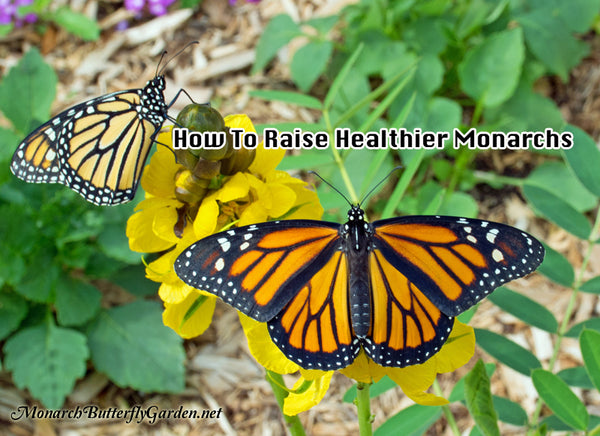
Raising healthy monarch butterflies relies on using simple raising techniques that promote monarch health and will prevent monarch diseases from occurring in the first place. The sad truth is, once your monarch larvae are sick, it’s usually too late to save them…
The explosion of comments and questions I receive about monarch diseases suggests they’re a common problem for many raisers. There’s still a lot of work to be done to help everyone raise butterflies with (at least) a 90% survival rate.
In the past few seasons, I’ve raised hundreds of butterflies from tiny monarch egg. The only casualties I’ve experienced are from carelessness (rushing cage cleaning), and accidentally bringing in monarch predators with milkweed…mainly small spiders.
Monarch disease and death do not have to be a regular part of your raising experience.
My goal is to bring you an awe-inspiring and joyful raising experience free of monarch diseases and death….or at least bring loss down to a tolerable level, so you can experience the joys of raising, while helping the struggling monarch population. Are you ready to get serious about disease prevention and raise healthy monarchs? Let's do this...

Here are 12 monarch health issues that can be largely avoided with a few simple precautions:
1. Tachinid Flies
Tachinid flies are hard to differentiate from all the other flies in your garden just innocently pollinating the milkweed. However, if they’re sitting still, look for hairy flies with big red eyes:

These parasitic flies lay tiny eggs on monarch caterpillars that will need magnification 🔍 for confirmation:
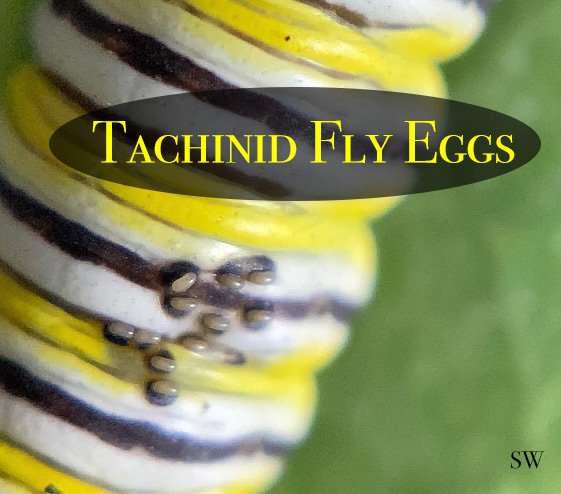
The hatching maggots burrow inside the caterpillar and feed from the inside out, eventually killing it. 🐛💀
You can typically tell your caterpillar’s been compromised when it starts to grow smaller and skinnier. Often, it will appear small if it attempts to pupate. The caterpillar often dies while forming its chrysalis. Soon after, white tachinid maggots will exit the caterpillar and repel to the cage floor, leaving long white strands of evidence hanging from the deceased caterpillar.

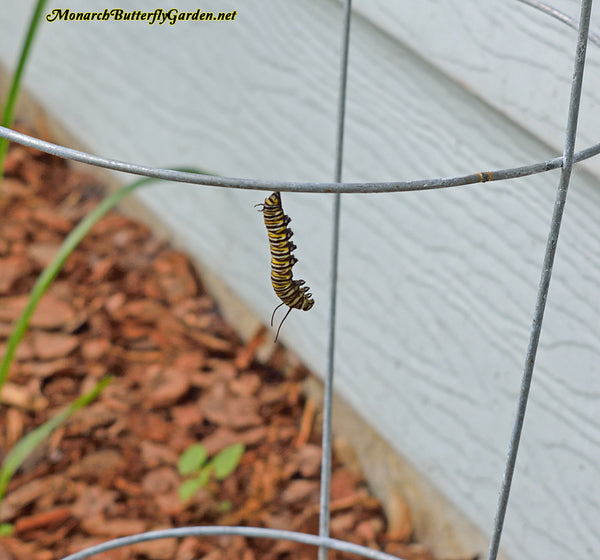
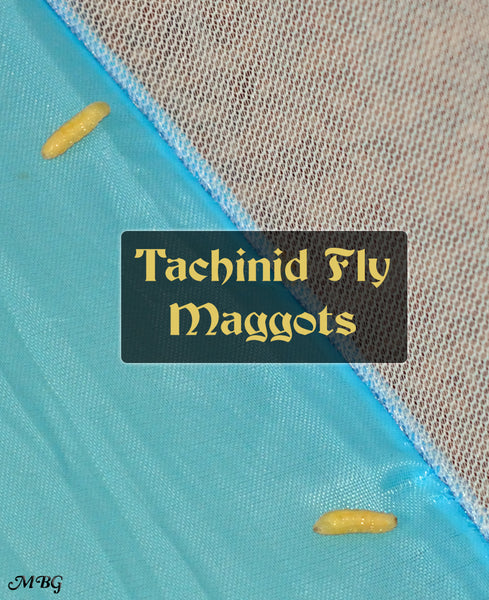
If the caterpillar still manages to form the chrysalis, you’ll start to see dark spots on the chrysalis in the next few days…the maggots will soon emerge. Soon after, they will each form a dark red pupa:

Prevention Tips:
- Only bring in monarch eggs for raising
- If bringing in caterpillars, try to collect caterpillars less than 4/10″ (instar 2 and smaller)
Although, I recently had maggots emerge from a small (instar 3) monarch caterpillar I was raising. It was likely parasitized as a small instar 1 or 2 caterpillar…
When tachinid parasitism occurs it’s very disappointing, but these parasites will not spread to other caterpillars in your cage, since they can only be spread by the adult flies. When you find maggots or red tachinid pupae in your cage, simply remove them and raise on!
2. Ophryocystis elektroscirrha (OE)
OE is a protozoan parasite that caterpillars ingest on milkweed. It’s spread through microscopic spores coming off the wings and bodies of adult butterflies. These protozoa multiply inside the caterpillar and can cause weakness, disfigurement, and an untimely death. You are most likely to notice symptoms of OE infection in the chrysalis or the butterfly. If you suspect your butterfly has severe OE infection, releasing it will only spread the parasite to future monarchs.
Prevention Tips:
- Rinse off milkweed with water before serving it to caterpillars
- Don’t let butterflies emerge from their chrysalides over feeding caterpillars
- Regularly clean out frass and rinse/dry your caterpillar cage
- In warmer regions where tropical milkweed grows all year, cut plants back to 6″ twice a year so fresh healthy foliage can emerge.
- Some also bleach eggs to kill OE spores and other pathogens in continuous growing regions
Want to know more about testing for OE + disinfecting monarch eggs, milkweed, and raising supplies? Click here
💀 BLACK DEATH 💀
3a. NPV (Nuclear Polyhedrosis Virus)
Commonly referred to as black death, your caterpillars will deflate, turn black, then liquify like something out of a horror movie! This virus can also affect chrysalides as the entire monarch chrysalis turns black.
Prevention Tips:
- Raise 5 Caterpillars MAX (per cage) so habitat is easy to keep clean
- Use a mesh cage that allows good ventilation, allowing water to evaporate
- Vacuum up frass, wipe down and dry cage daily
- Rinse milkweed cuttings and leaves with water before serving
- Clean cages with a diluted 5%-10% regular bleach solution (1 part beach to 10 parts water) at the end of every season, or use a pre-diluted chlorine bleach cleaner
- After bleach treatment, rinse cages thoroughly with water (and dry) before reusing or storing away.
- Caterpillars leaking fluid or refusing to eat for more than 24 hours should be separated from the rest
- If you have sick caterpillars or chrysalides turn black, disinfect the affected cage before raising more monarchs…and switch out the milkweed supply!
3b. Pseudomonas Bacteria
This bacteria can be found in soil and on plants. This bacterium thrives in warm, moist conditions which is why it’s important to have a habitat with good air flow where excess moisture can evaporate. Pseudomonas typically affect caterpillars that are already weakened by other diseases. Similar to NPV, monarch caterpillars and chrysalides will slowly fade to black death.
Prevention Tips:
- Raise 5 Caterpillars MAX (per cage) so habitat is easy to keep clean
- Raise Indoors (by open window) to keep caterpillars out of heavy rain
- Use a mesh cage that allows good ventilation, allowing water to evaporate
- Use stem cuttings instead of potted plants to eliminate soil from their habitat
- If using potted plants, cover the soil or water with a hydrogen peroxide mix to kill pathogens
- Vacuum up frass, wipe down and dry cage daily
- Rinse milkweed cuttings and leaves with water before serving
- Rinse cages with a weak 5-10% bleach solution at the end of every season
- Caterpillars leaking fluid or refusing to eat for more than 48 hours should be separated from the rest
- If you have sick caterpillars or chrysalides turn black, disinfect the affected cage before raising more monarchs…and switch out the milkweed supply!
4. Tainted Milkweed
It’s hard to imagine that anyone selling milkweed would treat it with pesticides, since the vast majority of milkweed customers are buying it to support monarch caterpillars and butterflies. Unfortunately, this is not always the case…
In the world of raising butterflies, tainted milkweed often rears its ugly leaves when people run out of milkweed for their caterpillars and are forced to make a milkweed emergency run to the nearest store/nursery. If you ever have to do this, make sure you are purchasing pesticide-free milkweed, or your poor caterpillars will never get the chance to finish their amazing transformation…
If your caterpillar has ingested pesticides it will often expel green vomit. If this happens, rinse the caterpillar off under a faucet, then place it on a new milkweed source immediately! If the current milkweed has been treated with systemic pesticides, the chemicals are inside the plant and can’t be rinsed off.
Another sign of pesticide poisoning is when a caterpillar dies in the middle of forming its chrysalis. This occurs when caterpillars ingest insect growth regulators, which include organic pesticides like neem oil.
Both of these events can be disturbing and disappointing, but here’s how you can largely avoid them:
Prevention Tips:
- Find local milkweed sources that grow plants without pesticides
- Find online milkweed resources that grow plants without pesticides
- Plant more milkweed in your garden to avoid having to make emergency runs
- Raise Indoors (by open window) so monarchs are safe from potential pesticide drift and/or mosquito spraying
- Realize pesticide companies are not referring to caterpillars when they list their products as safe for beneficial insects
growing tip: if you suspect nursery plants have been treated with systemic pesticides, cut them back to 6-12″ so healthy new stems and foliage can emerge. The regrowth will be fine for future caterpillars. (wait 60 days to use treated plants again, just to be on the safe side.)
Find Pesticide-free Milkweed Resources
5. Trichogramma Wasps
Until recently, I thought bringing in monarch eggs assured you of hatching healthy monarch caterpillars. But there’s a new parasite in town… Trichogramma wasps lay their eggs inside of monarch eggs. If your egg turns completely dark (instead of only dark on top) monitor it for 48 hours to insure it’s not a viable monarch. If it doesn’t hatch, squeeze the egg inside the milkweed leaf and discard or little wasps will emerge in about 10 days!
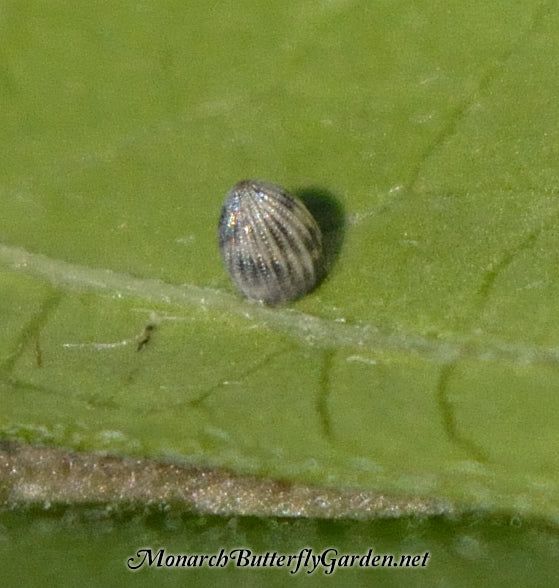
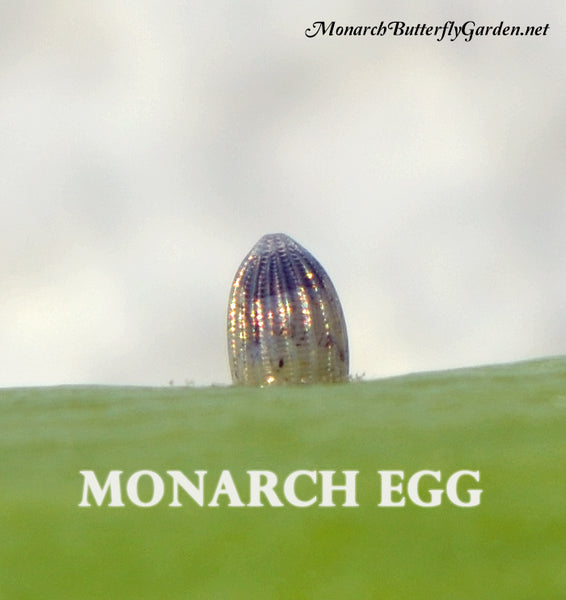
Prevention Tips:
- If you see a monarch female depositing eggs, collect them right away
6. Chalcid Wasps
These mini parasitic wasps stalk your j’ing caterpillar waiting for the perfect moment to parasitize it…right after the caterpillar forms a chrysalis. While it’s still soft, they lay their eggs inside. Hundreds of wasp parasitoids will eventually emerge from the chrysalis at the expense of your deceased monarch…
Prevention Tips:
- Use fine mesh enclosures to raise monarchs. Larger holes in laundry baskets will allow these impossibly small wasps access to your monarchs during this most-vulnerable time.
- Raise Indoors (by open window) where monarchs are safe from predators
- If raising outdoors, do not leave your habitat open for long periods while cleaning and check the cage for flying insects before closing
note: chalcid wasps are found worldwide, but concentrated in tropical and subtropical regions
7. Anal Prolapse
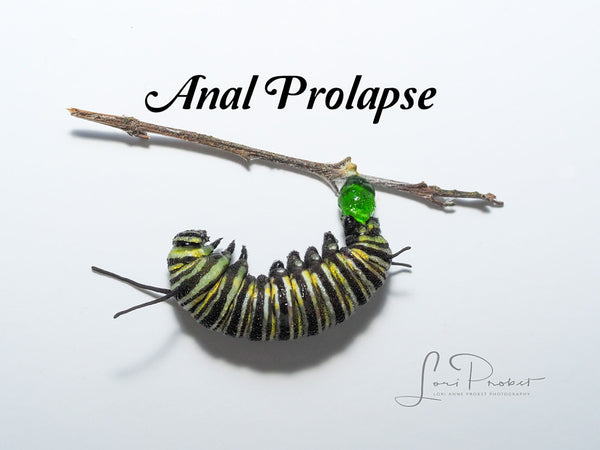
When this occurs the caterpillar’s rectum protrudes from its anus, leaving a vibrant green ball exposed at the end of your caterpillar. It’s not known what causes this, but it’s always fatal to the caterpillar.
8. Dehydration
I realize this isn’t a disease, but it’s a far too common problem that is taking precious monarchs away from us before they bloom into beautiful butterflies. Dehydrated monarchs can get stuck inside their chrysalides causing deformation and death. They may also have issues forming them.
Prevention Tips:
- spritz milkweed and caterpillars daily with a spray bottle filled with water- make sure the caterpillar cage has good ventilation (i.e. a mesh cage) so the water evaporates and there isn’t condensation inside the habitat that could cause disease
- Hydration of monarchs must start at the egg stage for healthy development
Some experts and enthusiasts disagree with spritzing milkweed leaves, but imagine eating food for two weeks without water…and staying healthy?!
9. Invisible Predators
These are the monarch predators that you unwittingly invite in to your cage, trapping them inside with your unsuspecting monarchs. I have done this with small spiders and stink bugs. This can be a problem when you raise on potted plants because of all the nooks and crannies where predators can easily avoid detection.
Prevention Tips:
- raise monarchs on small cuttings or individual leaves so it’s easier to inspect the milkweed
- thoroughly rinse milkweed with water before serving it up to monarch caterpillars
- spray potted plants with water to detect spider webs
10. Bacillus thuringiensis (BT)
This naturally-occurring bacteria is used in powders and sprays to protect food crops. It has become a widely used pest management tool to control the spread of gypsy moth caterpillars in spring, with all other caterpillars (including monarchs) becoming collateral damage.
When ingested, BT ruptures the gut lining of monarch caterpillars. The irritated caterpillar stops eating and will die within a few days.
BT can be legally used on certified organic plants.
Prevention Tips:
- don’t just ask if the plant was grown organically.
- do ask if Bacillus thuringiensis (BT) was used specifically
- don’t use BT around milkweed and other host plants
- thoroughly rinse any plants you think may have been accidentally exposed
11. Flea & Tick Treatments 🐱🐶
A community member recently contacted me with this cautionary tale…
She had just applied a topical flea and tick medicine on her cat. The cat had shown interest in the caterpillars and rubbed against their cage several times. Two days later, all of the caterpillars were on death’s doorstep and had to be euthanized.
If this happens to you, rinse caterpillars, cage, and milkweed with water and maybe they’ll recover. Otherwise…
Prevention Tips:
- keep pets recently treated with flea and tick medicine away from growing caterpillars.
- If you’ve handled a dog or cat that’s had a flea treatment applied, wash your hands before handling monarchs, milkweed, or raising supplies.
What should you do if you suspect your monarch has a disease or parasite, but aren’t 100% sure?
Isolate the egg, caterpillar, chrysalis, or butterfly and monitor it for confirmation of an issue. If the questionable individual is kept in a separate food container or mesh habitat, it will not spread potential pathogens to the rest of the monarchs you are raising.
12. Wood Butterfly Cages
Wood raising cages are hard to disinfect, which can cause ongoing disease issues. According to Monarch expert Dr. Karen Oberhauser:
“It is difficult to clean wood cages unless you have access to an autoclave. At Minnesota, we use wood and screen cages to rear larvae, and have successfully decontaminated them in an autoclave. If you use mesh or plastic cages, they can be decontaminated by soaking them in a 10% bleach solution (approximately 10 ml Chlorox bleach to 100 ml water) or 100% ethanol for at least 15 minutes, then rinsed well. Use the bleach solution to soak any tools that you use to transfer larvae, rinsing them after they are soaked. Wipe down countertops and other surfaces with the bleach solution in areas in which you have reared larvae or kept butterflies. The spores survive long periods of time (over a year), and can also survive freezing temperatures, so equipment that you used last year or left outside over the winter will still be able to infect larvae.”
Prevention Tips:
- Indoors- use mesh cages, plastic, or glass
- Outdoor options
Just an ounce of prevention in raising monarch butterflies will help you avoid monarch diseases, parasites, and death, so you can grow healthy monarchs through the entire monarch butterfly life cycle.
For further info on monarch disease and raising healthy butterflies, a ✬✬✬✬✬ rated PDF download on How To Raise More Monarchs, with Less Effort is available for purchase HERE <<< (choose paperback or PDF download)













